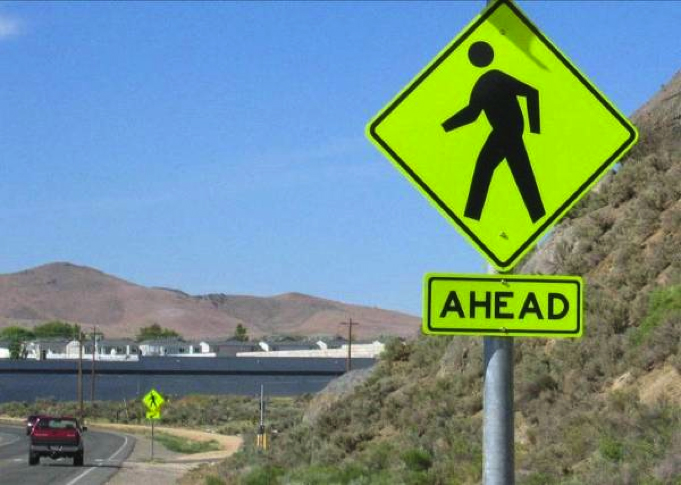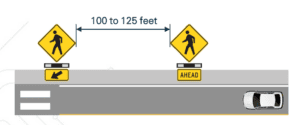As a pedestrian safety countermeasure, the benefits of rectangular rapid-flashing beacons (RRFBs) are well-documented. Commonly installed with crosswalk signage at midblock and other unsignalized crossings like roundabouts, they can increase driver yield rates to 98% and decrease crashes involving pedestrians by up to 47%, according to the FHWA.
But they are not a silver bullet on their own. Like all of the countermeasures identified in the FHWA’s Proven Safety Countermeasures initiative (PSCi), they are most effective when used in conjunction with other interventions and strategies. For RRFBs, that includes road diets, curb extensions, refuge islands, overhead lighting, and advance pedestrian warning signs, which we will cover in detail here.
What is an advance pedestrian warning sign?

Warning signs, as they are defined in the MUTCD, are non-regulatory (i.e., non-enforceable) roadway signs that give notice of a situation that might not be readily apparent. In the case of advance pedestrian warning signs, they tell drivers that they are approaching a crosswalk and should be aware of the potential for pedestrians on or near the roadway.
The sign the MUTCD recommends for this is actually the same one they recommend for the crosswalk—the W11-2. However, instead of pairing it with a downward-sloping arrow plaque (W16-7P), they suggest using an “AHEAD” (W16-9P ) or “XX FEET” (W16-2P) distance plaque. School crossing (S1-1) and trail crossing (W11-15) signs may also be used if appropriate.
When do you use an advance pedestrian warning sign?
One of the main criteria for a marked crosswalk is good sight lines, meaning the roadway ahead of the crosswalk is long enough that a driver traveling at or near the posted speed limit has time to perceive, recognize, and react—in this case, yield to—to an incoming pedestrian. The MUTCD calls this “Perception-Response Time” or PRT.
| Vehicle speed (mph) | Stopping sight distance (feet) |
| 15 | 80 |
| 20 | 115 |
| 25 | 155 |
| 30 | 200 |
| 35 | 250 |
| 40 | 305 |
| 45 | 360 |
| 50 | 425 |
| 50 | 495 |
Researchers have performed extensive tests to determine under a variety of conditions, the results of which can be found in the AASHTO Green Book. The table on the right shows the minimum recommended stopping sight distances on level roadways.
Many crosswalks, however, don’t meet these recommendations. Marked crosswalks are often located near horizontal or vertical curves, as well as in locations where obstructions like parked cars can block drivers’ view of a crosswalk. Scenarios such as these, where road users don’t have enough time or distance to see and react to changing conditions, are examples of when to use an advance pedestrian warning sign.
Can an RRFB be added to an advance warning sign?
Yes! Adding an RRFB light bar to an advance warning sign is a highly effective way of enhancing sign conspicuity and driver compliance. If driver sight distance approaching the crosswalk is low, an additional RRFB may be installed on the approach in advance of the crosswalk. This advance RRFB is supplemental and cannot replace RRFBs at the crosswalk. The advance RRFB system should communicate with the RRFB crossing.
Where should the advance warning sign/RRFB be placed?

MUTCD guidance recommends warning signs be placed so they provide adequate driver perception-response and stopping sight distance. They should also not be placed too far in advance of the crosswalk such that drivers forget the warning because of other driving distractions.
RRFBs may not be sufficient on roads with speeds of 40 mph and greater.
In summary, advance pedestrian warning signs can and should be used on roadways where sight lines are limited or where pedestrian crossings may not be expected by motorists. The MUTCD has approved the use of RRFBs with advance pedestrian warning signs and offers some guidance on their placement. However, transportation professionals should always consult their local DOT and exercise engineering judgment. As they say, your mileage may vary!
